I have a View which has two labels and a Table View inside it. I want label 1 to always stay above my Table View and label 2, to be below the Table View. The problem is that the Table View needs to auto-size meaning either increase in height or decrease.
Right now I have a constraint saying the Table View's height is always equal to 85 and a @IBOutlet to the height constraint where i'm able to change the constant.
I'm guessing I need to change the constant to the height of all the cells, but i'm not sure how.
